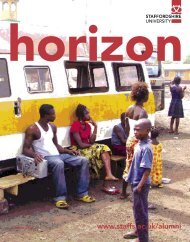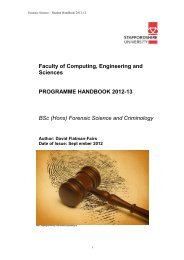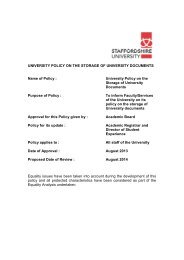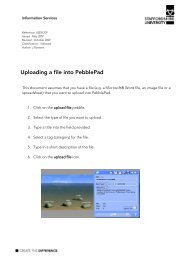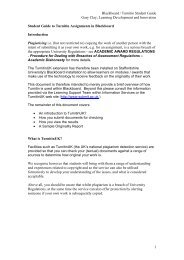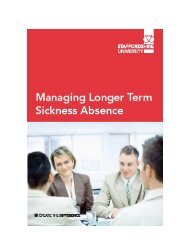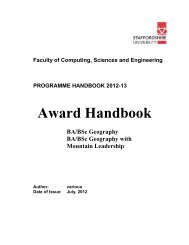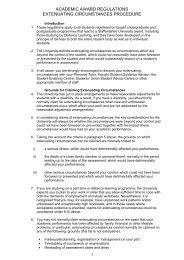Paramedic Practice - Staffordshire University
Paramedic Practice - Staffordshire University
Paramedic Practice - Staffordshire University
Create successful ePaper yourself
Turn your PDF publications into a flip-book with our unique Google optimized e-Paper software.
From these tables you will note that during your programme there are two full time<br />
practice placements (practice placements 3 and 6). In these two placements, you<br />
will undertake a summative assessment of your practice against identified practice<br />
outcomes (see Clinical <strong>Practice</strong> Assessment Document).<br />
4.3.1 Clinical <strong>Practice</strong> & Minimum <strong>Practice</strong> Requirements<br />
The Foundation Degree in <strong>Paramedic</strong> Science is designed to further develop your<br />
knowledge, skills and abilities in becoming a capable, competent and caring<br />
paramedic practitioner in the out of hospital setting. To achieve this requires you to<br />
gain clinical experience during your programme and is a key component to meet the<br />
HPC Standards of Proficiency (HPC 2007). The experiences gained whilst working<br />
in the out of hospital environment are essential to the achievement of the foundation<br />
degree and will also be used to enhance your learning in other university based<br />
modules of the course.<br />
„The „Foundation Skills in <strong>Paramedic</strong> <strong>Practice</strong>‟ and „<strong>Paramedic</strong> <strong>Practice</strong> & Role<br />
Development‟ (60 credits each) has a strong clinical focus and comprises of 50% of<br />
your coursework for each year and incorporates work based learning achieved<br />
through practice in a health care environment. Both modules require you to be<br />
formatively and summatively assessed in clinical practice to demonstrate your<br />
achievement of practice, knowledge and skills. Therefore it is important that you<br />
maintain your work based learning competencies and maintain records of your<br />
experiences.<br />
Both modules have been designed in accordance with the curriculum framework for<br />
ambulance education (BPA 2006) and the Code of <strong>Practice</strong> for the Assurance of<br />
Academic Quality and Standards in Higher Education (Quality Assurance Agency<br />
(QAA) 2007) and each module requires a minimum of 750 hours in a work based<br />
learning environment with mentor support. In addition, both modules will enable<br />
you to meet competency outcomes identified in the Standards of Proficiency (HPC<br />
2007)<br />
The timing of work based learning will allow some flexibility, although it is essential<br />
that certain parameters are met to ensure opportunities to link university based<br />
learning to practice, facilitate reflection on work based learning and ensure that<br />
assessment deadlines can be met. Work based learning will be shaped by the<br />
practice outcomes for the modules, assessment requirements and objectives<br />
arising from student‟s personal development plans.<br />
The course leader will also arrange placements for each student. The majority of<br />
clinical placements in your Award will be in the out of hours setting but you will also<br />
gain experience through placement in other areas where specialised experiences<br />
essential to your Award are available.<br />
4.4 Award Structure<br />
The award is modular in design and comprises of 8 core modules in total; 4<br />
modules at Level 4 (certificate) and 4 modules at level 5 (Intermediate). The<br />
modules attracts 2 x 15, 1 x 30 and 1 x 60 Credit Accumulation Transfer (CAT)<br />
Points for each year (see table 3 and 4) with each module studied and assessed as<br />
a discrete entity. However, all modules will relate closely to each other and as you<br />
10



